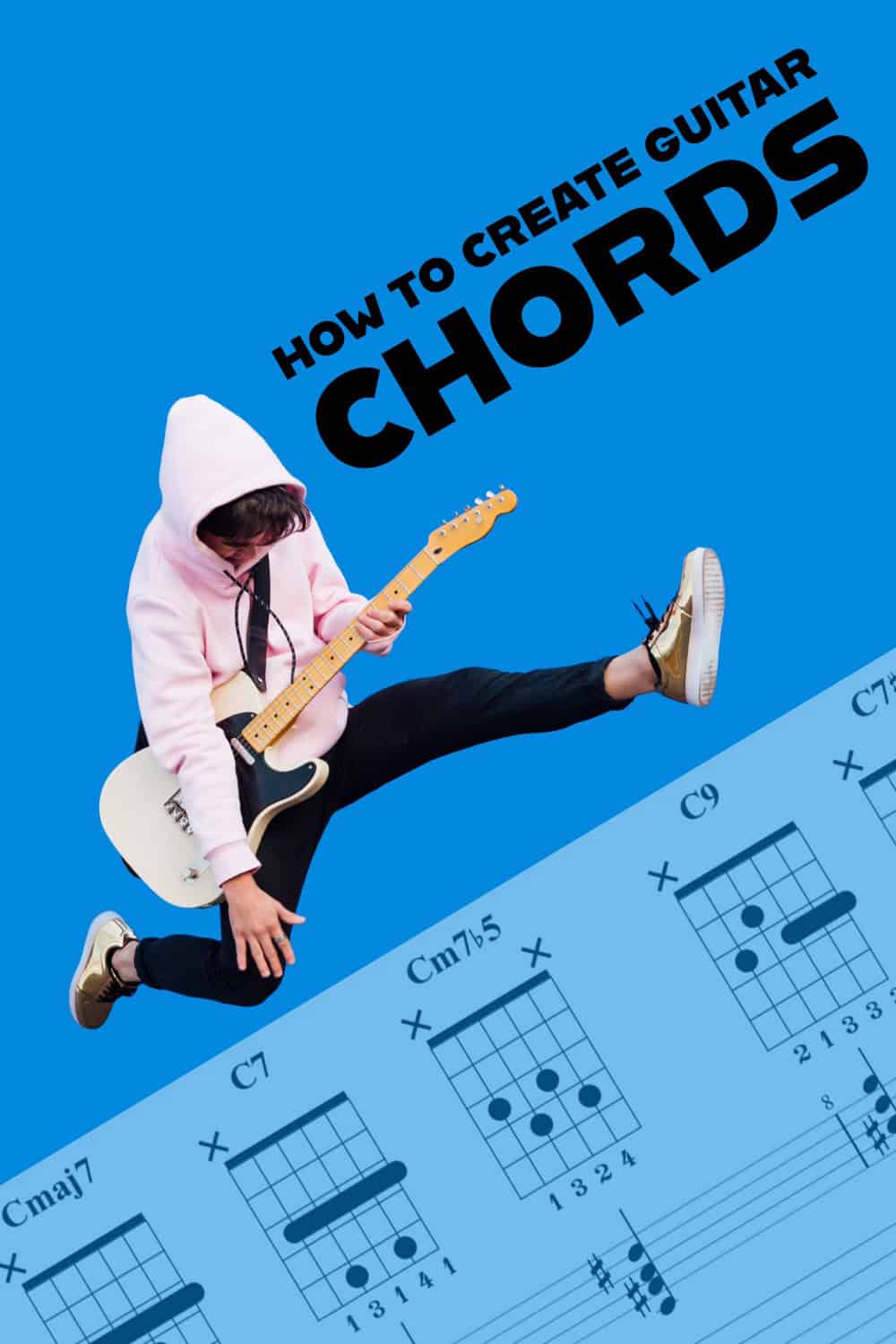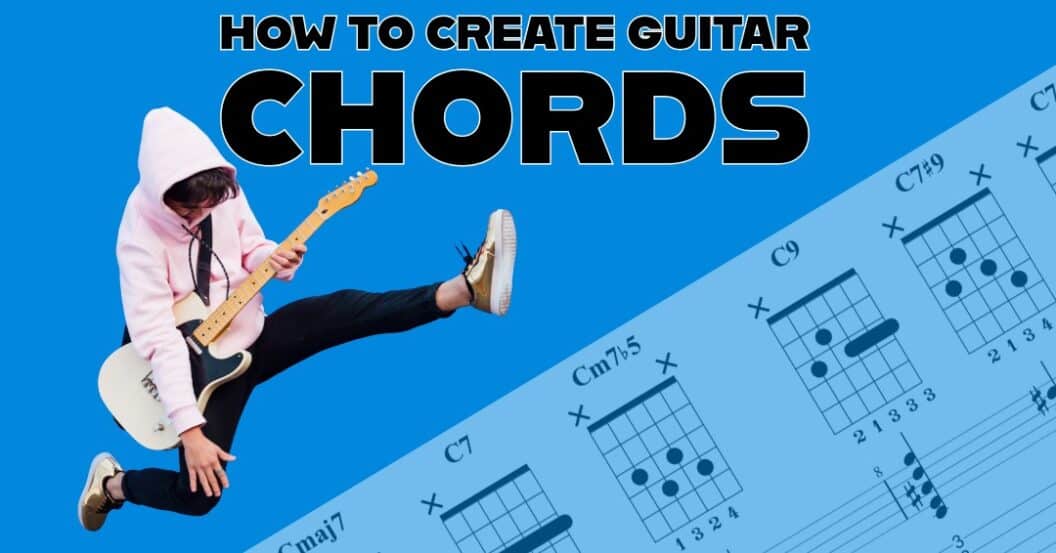Creating Guitar Chords
Think it’s hard to create your own guitar chords? Let me tell a quick story.
A few years back I had an adult student, far from a beginner mind you, but he was struggling with chords and some basic chord theory. He had this book called “10,000 chord shapes” (I swear that’s a real book!) and he was convinced that he had to learn all of those shapes to become the guitarist he wanted to be.
Not only was the concept of a book containing 10,000 chord shapes just ridiculous… There wasn’t one paragraph, page or chapter that explained a single thing about the chords themselves aside from the names.
This would be akin to teaching someone the English language by giving them a dictionary to memorize. Could you imagine?
There are quite a few books out there like this.. Just gobs of meaningless guitar shapes and diagrams compiled by someone trying to make a quick buck off of some unsuspecting beginner guitarist.
The CAGED Guitar Chord System
You may have heard of this system that takes some of the common open position chords (like C in example 1. below) and “closes” them up and enables you to move them around the fretboard.
Ex.1 – C Form in the CAGED System
Do you really need to memorize a system to get that? Isn’t that kind of common sense even for a relatively new guitarist?
I don’t necessarily have a problem with learning shapes this way, but again, no music theory, no explanation of WHY this works... Yet it is taught exhaustively all over the internet and beyond. I even recently read a long diatribe from another Guitar Blogger defending the CAGED system and why HE likes it… yet nowhere in the article or lesson was one bit of info on what MAKES A CHORD A CHORD... well, this really bothered me.
So what happens if you want to add a 7th or 9th.. or a b5 etc. al.?
What if I want to change or add a note in one of the chords in the CAGED guitar system.. What is that chord called now? You’ll never know …. because the CAGED system simply falls short of explaining what a chord really is and how to make them from scratch.
So how do we do it?
Starting With The Major Scale
For every example, in this article (and my book) I will always start with some type of parent scale from which to build from. If you’re new to scales and scale theory, check out my Scales for Guitarists article for a quick crash course, then come back here and learn how to build some chords on the guitar.
When you start with (and understand) where the notes in the chords come from, you’ll be able to create an infinite number of chords all over the neck… the music theory also transcends the guitar, so you can easily apply this theory to the Piano or any other musical instrument.
For the sake of simplicity, let’s start with the C Major Scale.
C D E F G A B C
- All white Keys on the Piano.
- No Sharps (#) or Flats (b)
Let’s start with 3 Formulas for building Chords/Triads in EVERY key:
- Major – 1 + 3 + 5 (from the scale)
- Minor – 1 + b3 + 5
- Diminished – 1 + b3 + b5
In every Key (Major Scale) there will be 3 Major chords, 3 Minor Chords and 1 Diminished Chord.
I – Major
ii – minor
iii – minor
IV – Major
V – Major
vi – minor
vii – Diminished
In C Major that looks like this:
C Major Triads:

I – C Major
ii – D Minor
iii – E Minor
IV – F Major
V – G Major
vi – A minor
vii – B Diminished
Right out of the gate you see with this more focused method starting with an actual scale, we have 7 chords in a key that all work together. Not just some meaningless shapes and diagrams.
You can mix and match, write songs, riffs, solos or whatever you like.. And they will all just work together in every key.
Also worth noting, this is the same method you can use to create arpeggios across the neck in any key.
The CAGED system starts with 5 completely unrelated chords forms that don’t all work well together because they’re not (all) in the same key… and it completely eliminates an important diatonic chord- The vii – Diminished!
Want some printouts of these chords (also scales, arpeggios and other exercises)? Get on my email list to get FREE access to my guitar printables library. I usually send out 1-2 emails per week with other Guitar Lessons, Article Updates and other Guitar Goodness. Unsubscribe at any time.
Also, check out my eBook The 7 Day Practice Routine For GuitaristsNow that we understand basic diatonic harmony and how to build chords, triads or arpeggios in every key, let’s get it onto the guitar neck.
You probably already know a handful or even a bunch of chord forms.
- Do you really know what you’re playing?
- Could you easily transpose them into other keys?
- Do you know the notes on the guitar fretboard?
Notes on the Guitar Neck
Let’s get this out of the way. Learning the notes on the guitar neck is easy and also essential to really making the most out of everything you learn on the guitar.
If you already know the notes on the neck, good for you! Skip down to the next section to continue the chord building lesson.
All you have to remember are 7 simple rules:
- Music notes are in alphabetical order (A thru G)
- There are always half-steps (semi-tones) between B-C and E-F
- All of the other notes are a whole-step (whole-tone) apart:
A-B, C-D, F-G, G-A - 1 Fret is equal to a half-step.
- 2 Frets is equal to a whole-step.
- The alphabet starts on the open string and continues up the neck.
- At the 12th fret everything starts over.
Notes on the Low E String
With this information, let’s put some notes on the neck starting on the LOW E String:
Remember Rule #6:
The note open is “E”, so thats where the musical alphabet starts on that string.
Remember Rule #2:
- Half-Steps between E and F and again between B and C.
- After the open E, we go right to F on the first fret, then skip a fret to G on the 3rd.
- The half-step repeats again from B to C on the 7th and 8th frets.
Rule #7:
It doesn’t matter if your guitar has 14 frets or 24… you only need to memorize the pattern up to the 12th fret. After that, it just repeats the alphabet as high as your frets go.
The dots on the guitar neck really don’t mean a lot do they? I mean.. There isn’t a scale or key that perfectly lines up with them. They’re strictly visual aides. They don’t really correspond to any specific key, chord, scale or pattern.
Piano Keys
Piano players don’t know how good they have it right? White Keys and Black Keys.. It’s so simple visually:
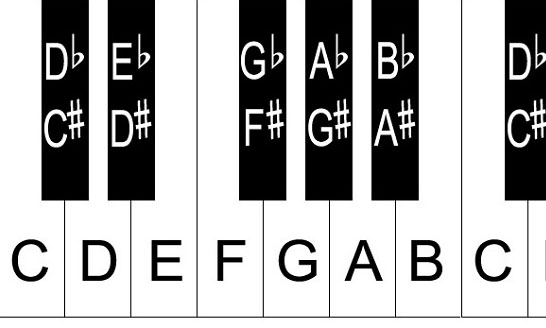
As Guitarists, we’re struggling with a random pattern of frets and dots on 6 strings. It’s like looking at 6 pianos (upside down!) with no colors to help us visualize notes.
Now that we understand how to find notes on 1 string, let’s map them out all over the neck:

Fairly painless right?
If this concept is new to you, you may be asking yourself.. “Ok what about all those frets with no notes on them.. The ones we skipped a whole-step?”
Those are the sharps (#) and flats (b) like the black keys on the piano.
- You could think of those frets as sharps going forward. For example, moving from F on the first fret, F# would be on the 2nd fret.
- You can think of them as flats going backward. For example, G on the third fret and Gb backward to the second fret.
But wait… Is the 2nd fret an F# or Gb, how can it be both?
Enharmonic Notes on Guitar
Well, it’s really not both. It could be either depending on what key you’re in. Calling a note a sharp or flat really depends on the key (parent scale) and how you spell out its scale tones.
I purposely left off the sharps and flats in the above graphic. I’ve always felt that is better for guitarists not to associate those frets with one or the other, unless you know what key (parent scale) you’re playing in.
For example, in the key of G Major, we have one sharp note, F#:
G A B C D E F# G
It’s important that when playing in the Key of G Major I think of those notes between F and G as F# due to the Key Signature of that parent scale… and not Gb which messes up the spelling and scale alphabet.
Do you know the Circle of Keys and how to find all of the Sharps and Flats in any Key? If not, I have a beautiful, printable PDF of the circle in my Printables download area.Spelling Scales Properly
Think of it like this, if I were to call it a Gb that would make for some dubious spelling of the scale:
G A B C D E Gb G …Whoa… Nope! That doesn’t work.
Using the F Major Scale as another example, it contains one flat note (Bb). It spells out like this:
F G A Bb C D E F
(If you missed the lesson on the circle of keys and how to construct scales check it out.)
If we were to call that Bb an A#, we’d have another alphabet and scale spelling catastrophe:
F G A A# C D E F
… So that’s why there is a need for #’s AND b’s in music. So we can spell things out correctly depending on the key we are in. It can be a bit confusing, but hey, this stuff has been around for the better part of 500 years without any changes. You’ll get it!
Whew! I know that was exhausting right? …But it really needs to be understood. I think so many guitarists avoid learning this stuff because it’s not explained in a simple way.
Building Simple Guitar Chord Forms
Ok, now that we know the notes on the neck, we can start building our own chord forms in any key.
Chords You Already Probably Know.
One of the first chords you learned on the guitar, a simple, open-position C Major chord:

Lets take a look at what it’s made up of:
- 3rd Fret, A String: C (1)
- 2nd Fret, D String: E (3rd)
- 3rd String, open: G (5th)
- 1st Fret, B String : C again
- Open E String: E again
So back to our Major chord Formula: 1 + 3 + 5 = Major Chord
We have a 1, 3, 5, plus another 1 and 3 on the top end of the chord.
Using the theory and the notes on the neck we can create C Major Chords all over the place (similar to the CAGED system but with a bit more theory and thought involved).
Remember any combination of C + E + G = C Major chords or arpeggios.

We end up with overlapping C chord forms all over the neck.
Inversions and Slash Chords
Worth noting is that you don’t need to always make the 1 (root) the lowest note in the chord. Granted, on guitar and most popular music that is the way it’s done.. But you can feel free to flip them around any way you like, as well as repeat chord tones in any shape.
Chord Inversions
There are 2 basic inversion types you can use to create chords.
- 1st Inversion – The 3rd in the bass (lowest note)
- 2nd Inversion – The 5th in the bass
If you’e ever seen some TABS or a chord chart with a slash chord like C/E, and wondered what that means, it’s just a 1st inversion C Major chord with the E in the bass.
We’re taking our orginal C Triad: C + E + G and moving the 3rd (E) into the bass.
E + C + G (or any order you want as long as E is in the bass)
Here are a few examples of slash chords:
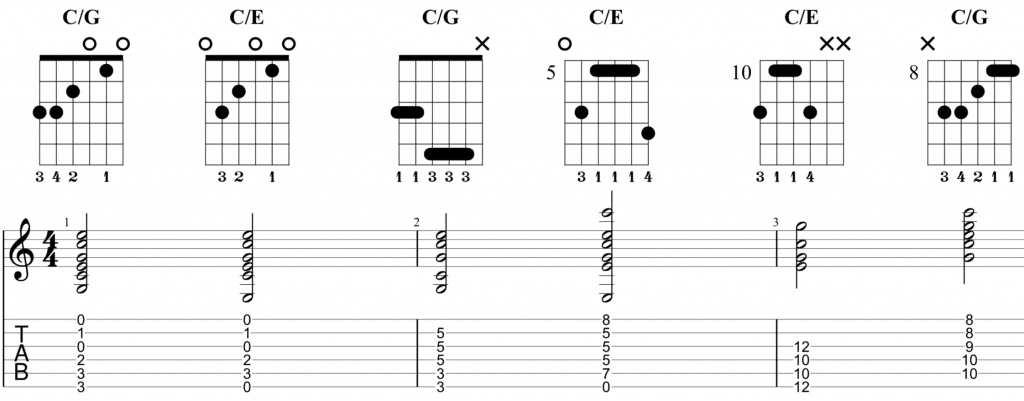
More Chord Formulas for Guitar
Now we can expand the harmony of our boring little triads by adding some 7ths to each chord.
Here are the Formulas for the new chords:
-
- Major 7 = 1 + 3 + 5 + 7
- Minor 7 = 1 + b3 + 5 + b7
- Dom 7 = 1 + 3 + 5 + b7
- m7b5 = 1 +b3 + b5 + b7
 <
<
7th Chords for Guitar
We now end up with a new and expanded set of chords:
- I – C Major 7
- ii – D minor 7
- iii – E minor 7
- IV – F Major 7
- V G Dominant 7
- vi- A minor 7
- vii – B minor 7b5
Now try to create some shapes using these new expanded formulas. In no time you’ll have a huge chord vocabulary … and the best part is, you’ll actually understand what it is you’re playing… not just learn a bunch of random diagrams out of a book.
The Theory will set you free!
My Favorite Way To Learn New Guitar Chords
A more refined way of creating your own chords all over the neck is to understand and locate the intervals throughout the parent scale or root note.
Using this method you are able to create an infinite number of chord shapes on the fly, without having to memorize thousands of shapes and diagrams.
Lets take our C Major Scale as an example in the 3rd position:
In this diagram (and the one below) the numbers are scale tones (1-13), not the fingers of the fretting hand.
If we number our C Major Scale Chromatically from 1 to 13 it will look like this:
GREEN = NOTES IN KEY
Black = NOTES OUT OF KEY
C Major Scale
C – 1 or Root
C#/Dd – b2 (although this would be quite uncommon)
D – 2nd
D#/Eb – Minor 3rd (b3)
E – Major 3rd
F – 4th
F#/Gb – Flat 5 (b5)
G – 5th
G#/Ab – #5
A – 6th
A#/Bb – b7
B – Major 7th
C – Root
C#/Dd – b9
D – 9th
D#/Eb – #9
E – Major 3rd (We never say “10th” in music)
F – 11th
F#/Gb – #11
G – Major 5th (we never say “12th” in music)
A- 13th
Guitar Fretboard Note Intervals
Now let’s put every interval in the pattern that’s available and within reach of the left hand.
I’ve always taught my students that if you know your alphabet from A to G and count to 13, you can create ANY chord in existence. …and if you know how to find the notes on the fretboard you can do it all over the guitar neck in any key!
Just by grabbing some of the notes in and around the C Major Scale, we can create a bunch of cool chords. You may know some of these already but I bet now you understand them a lot better!
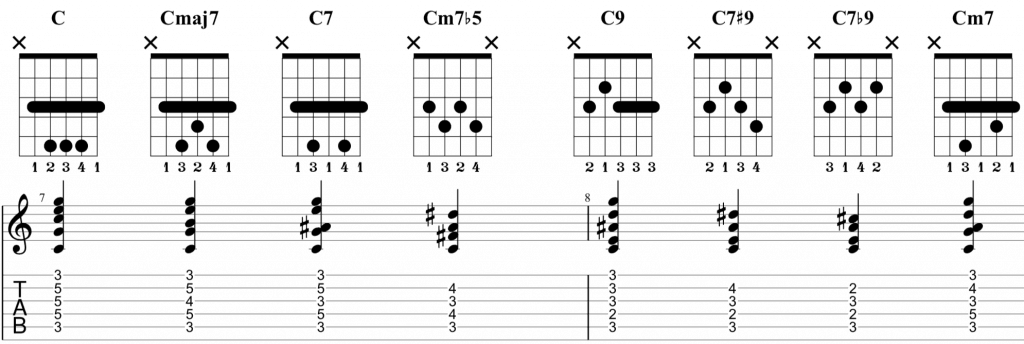
More Chords in C
Now Let’s try making a few common chords from the 8th position C Major Scale.
- Map out the notes on the neck in the 8th position.
- Try coming up with some new chords.
- Compare your list to the ones below.
C= 1 + 3 + 5
C7 = 1 + 3 + 5 + b7
C7#5 = 1 + 3 + #5 + b7
CMaj7 = 1 + 3 + 5 + 7
C13 = 1 + 3 + b7 + 13
Cm7 = 1 + b3 + 5 + b7
Cm9 = 1 + b3 + 5 + b7 + 9
C6 (Maj6) = 1 + 3 + 5 + 6
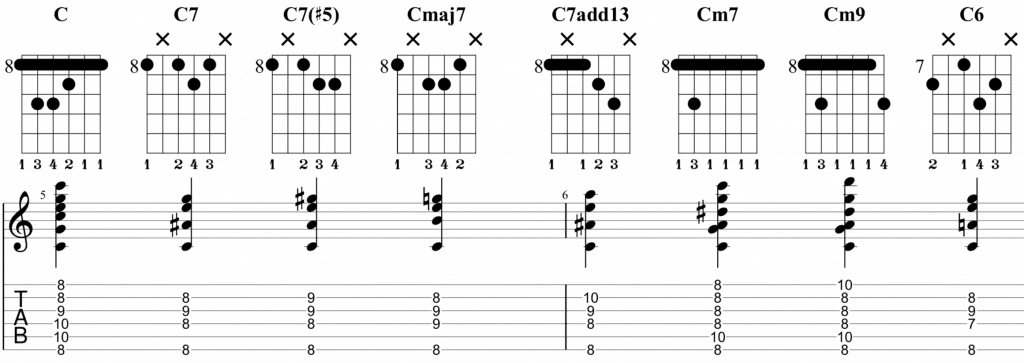
13th Chords for Guitar
The Formula for a 13 chord is:
1 + 3 + 5 = Major triad
Plus a b7 – (Bb)
Plus a 9th and 11th and 13th:
C + E + G + Bb + D (9th) + F (11th) + A (13th)
Whoa!.. wait a minute there are 7 notes in that chord and we only have 6 strings! Impossible right? Well not if you play the piano… but on guitar we’re going to have to make some sacrifices to get this under our fingers.
It is perfectly acceptable practice to eliminate (or add) ambiguous chords tones.. or those scale degrees that don’t effect the overall tonality of the chord.
Ambiguous chord tones could be the 4th, 5th, 6th, 9th, 11th.
- We probably wouldn’t want to eliminate the 3rd because it gives us our Major tonality.
- The b7 is important for the Dominant 7th sound of the chord.
- The 13th is directly called for in the chord name, so it’s gotta be there too.
Closing
Ok… now try to make up some guitar chords of your own.
Pick up a Jazz fake book or find some free charts on the internet and work on building your chord repertoire by making your own chords using the formulas and notes on the neck.
I highly recommend that every Guitarist own a REAL BOOK or “Fake Book”. It’s jam packed with standards and chords you may not be familiar with. There’s no better way to practice this stuff than to just sit down and do it in a real song.
Until next time,
Craig
Craig Smith is a professional Guitarist, Teacher, and Writer living in Sanford, Florida. Craig has taught guitar lessons, performed 200+ gigs per year for nearly 30 years, and published 4 guitar instructional books. When he’s not gigging or writing, you may find him by the pool with his wife Celeste, 4 Chihuahuas, and a drink. 🎸

